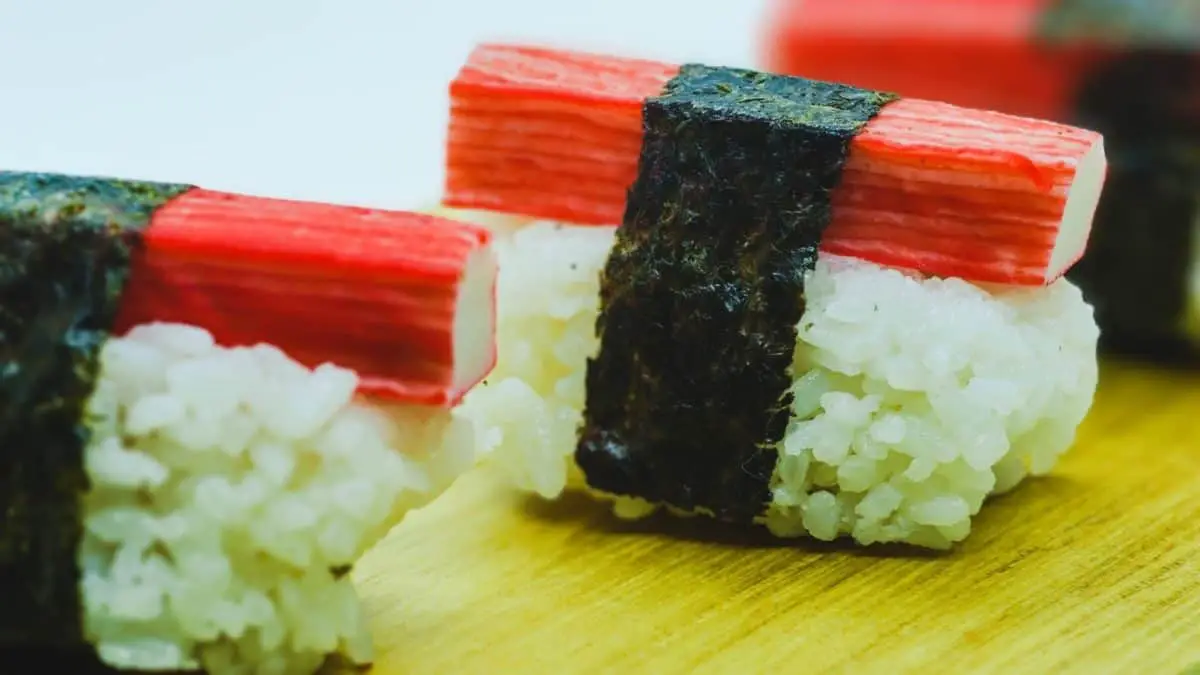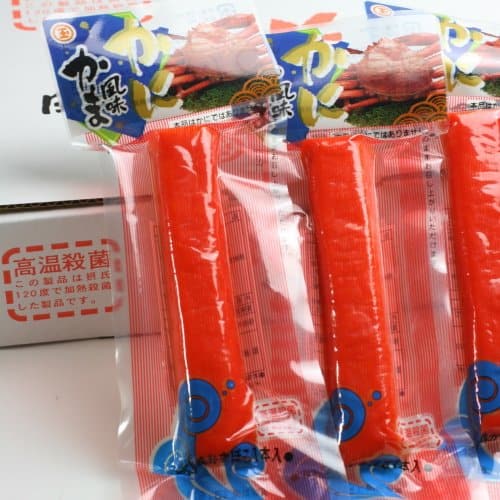Kanikama: The Original Imitation Crab Sticks
Kanikama or kamaboko crab is a type of Japanese fish cake. It’s made from surimi, a type of minced fish, and usually has a pink or red hue. It’s meant to resemble crab meat and is considered imitation crab meat.
Crab sticks (imitation crab meat, seafood sticks, krab) are a form of kamaboko, a processed seafood made of finely pulverized white fish flesh (surimi), shaped and cured to resemble leg meat of snow crab or Japanese spider crab.

Crab flakes use the same mixture to form flakes instead of sticks to resemble crab meat or lobster meat.
Kanikama is often used as a filling or topping on sushi, and can also be found in soups and other dishes.

Check out our new cookbook
Bitemybun's family recipes with complete meal planner and recipe guide.
Try it out for free with Kindle Unlimited:
Read for freeIn this post we'll cover:
- 1 What does “kanikama” mean?
- 2 What does kanikama taste like?
- 3 Best kanikama to buy
- 4 What’s the origin of kanikama?
- 5 How to store kanikama?
- 6 What’s the difference between kanikama and kani?
- 7 What’s the difference between kanikama and surimi?
- 8 What’s the difference between kanikama and snow crab?
- 9 Is kanikama healthy?
- 10 Conclusion
What does “kanikama” mean?
Kanikama is short for kani-kamaboko and literally means “crab fish cakes”, “kani” is crab in Japanese and “kamaboko” are fish cakes. So it’s fish cakes meant to look and taste like crab meat, even though there’s no crab in them.
What does kanikama taste like?
Kanikama has a mild, sweet flavor with a slightly fishy taste. The texture is chewy and slightly rubbery.
It doesn’t taste like crab meat in my opinion, but added to a dish as a topping, filling, or garnish can make the dish look more expensive and the flavors blend well.
What kind of fish is kanikama?
Kanikama is made from surimi, which is a type of minced fish. The main ingredient in surimi is usually pollock or hake. It’s often flavored with salt, MSG, and other seasonings.
Best kanikama to buy
I personally like to work with these larger crab sticks from Marutama Fisheries because it’s hard to find others that have an authentic taste. Plus the large size is great for adding it to larger sushi rolls:

What’s the origin of kanikama?
Kanikama was invented in Japan in 1974 by Sugiyo Co. It was patented as Kanikama, which was a type of flake at the time, but soon the Osaki Suisan Co saw an opportunity and created imitation crab sticks out of the mixture in 1975.
How is kanikama made?
The mixture is then shaped into logs or sticks and steamed. Once it’s cooled, it’s ready to be used as a filling, topping, or garnish in various dishes.
How to store kanikama?
Kanikama can be stored in the fridge for up to a week, or in the freezer for up to a month. When stored in the freezer, it’s best to thaw it in the fridge overnight before using it.
What’s the difference between kanikama and kani?
Kanikama is imitation crab made from surimi, while kani is actual crab meat. Kani has a richer flavor and a firmer texture. It’s also more expensive than kanikama.
What’s the difference between kanikama and surimi?
Surimi is the main ingredient in kanikama. It’s a type of minced fish that’s usually flavored with salt, MSG, and other seasonings. Kanikama is shaped into logs or sticks and then steamed.
What’s the difference between kanikama and snow crab?
Snow crab is a type of real crab, while kanikama is imitation crab made from surimi. Snow crab has a sweeter flavor and a firmer texture than kanikama but you have to pay more for it so for some dishes that’s just not feasible.
Is kanikama healthy?
Kanikama is low in fat and calories and is a good source of protein. It also contains calcium, iron, and other minerals.
Conclusion
Kanikama is a stick that’s confused a lot with either actual crab meat or other types of kamaboko. But it’s delicious to add to your sushi or dishes nonetheless!
Also read: this is how you tell kamaboko and narutomaki apart
Check out our new cookbook
Bitemybun's family recipes with complete meal planner and recipe guide.
Try it out for free with Kindle Unlimited:
Read for freeJoost Nusselder, the founder of Bite My Bun is a content marketer, dad and loves trying out new food with Japanese food at the heart of his passion, and together with his team he's been creating in-depth blog articles since 2016 to help loyal readers with recipes and cooking tips.
